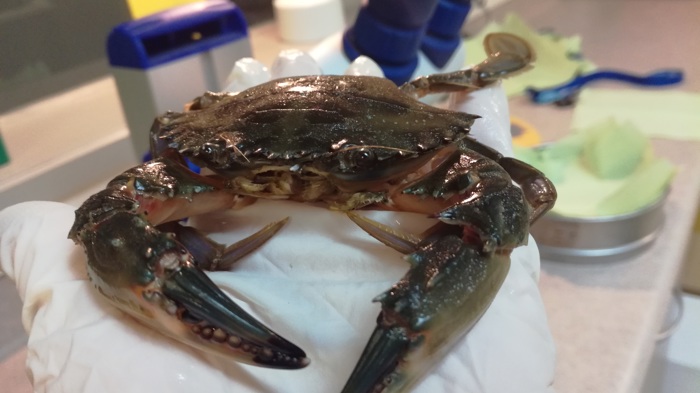Asian paddle crab


Asian paddle crab
Notify council
What does it look like?
In New Zealand they are typically found in estuaries. Asian paddle crabs are relatively large swimming crabs with paddle-like hind legs. The carapace of adults can reach 12cm across and is covered in small hairs (which are not always visible). The adults also have six distinct spines or spikes on each side of the carapace below the eyes. There are also five prominent spines on the upper surface of each claw. The crabs range in colour from pale-green or olive-green to a deep chestnut-brown with purplish markings on the shell.
In its native range of South East Asia, the Asian paddle crab occurs in inter-tidal and sub-tidal habitats to depths of about 15m, including sandy, muddy or rocky reefs. In New Zealand they are typically found in estuaries where there is firm sand, muddy fine sand, or muddy-shelly fine sand. They are generalist predators that feed mainly on shellfish, crustaceans, fish and polychaete worms.
Why is it a problem?
These crabs are very aggressive and have the potential to compete with native crabs for space and food. They also prey on native species including shellfish, fish, other crustaceans and polychaete worms. This species has a number of life history traits that make it a good invader: a long larval life that facilitates spread, rapid growth to maturity, high reproductive rates, high environmental tolerance and a broad diet.
Adult paddle crabs can produce hundreds of thousands of offspring annually; with female egg production averaging at 85,000 eggs which they may release several times per year. The larvae are able to withstand a wide range of water temperatures and salinities and can float in the water for three to four weeks, during which time they can be moved large distances by tides and currents.
Control methods
Please report sightings of Asian paddle crabs to help us understand their total distribution.
You can help prevent the spread of marine pests by:
- Regularly cleaning your boat’s hull – ideally keep fouling growth to no more than a light slime layer.
- Applying a thorough coating of antifouling paint and keep it in good condition.
- Ensure your hull is clean and free of fouling before you travel to a new area.
- Clean and dry any marine equipment (e.g. ropes, lines and pots) before using in a new area.
- Inspect areas on your boat that retain water for signs of marine life.
- Check for aquatic weeds tangled around anchors, trailers and other equipment.
Exception to Rule 10.23, 10.24 and 10.25
Any person, company or stakeholder that wishes to catch Asian paddle crabs for commercial purposes must apply in writing for a permit from Northland Regional Council.
Related information
Management programme
Sustained control
Rules
More images




